We are moving very rapidly from an era in which AI had a limited role in an enterprise, to an era in which there is an opportunity to ‘Reimagine the enterprise with AI’. That is, AI could serve as the backdrop against which many areas of an enterprise could be reimagined, incrementally or even ground up.
Many new start-ups across industries are embracing an AI-first business model. Even in businesses that have been around for a while, technology and business leaders and executives have started asking questions: What are the areas we can apply AI to? Where do we start? Are we ready? How do we scale?
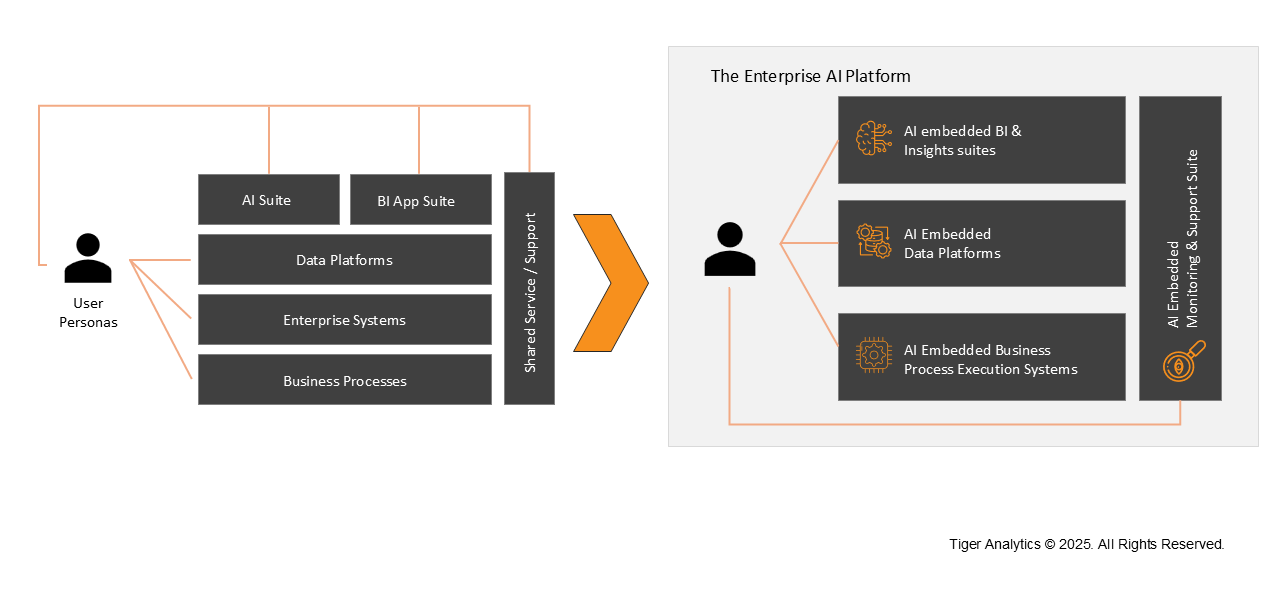
The evolution from AI in the enterprise, to enterprise against the AI backdrop.
Left at just ‘(re)imagination’, it remains an idealistic notion. There is also a need to ‘reengineer’ a bit of the enterprise technology landscape as well, to bring about the best of what AI has to offer in unlocking value.
An effective playbook for this transformation requires:
- Understanding the ‘Agents’ of change (agentic AI, that is).
- Thinking of a platforms approach early on, to be assured pilots can scale.
- Casting a wider net to identify opportunities to impact through AI, across Process Management, Data Management, Insights delivery, and Business + Technology support.
- Matching top-down efforts with a bottom-up ‘AI for Personas’ approach, to drive both adoption and value at scale.
- Developing and articulating a clear execution strategy for the above.
Of the above, the first two points are related to ‘reengineering the technology landscape’ to build AI foundations, the next two are about ‘reimagining the enterprise’ – areas you could apply AI to, and the final point about having a clear strategy for bringing everything together. Rather than representing a sequence of interventions coming one after another, these three key elements need to come together in a synchronized manner.
Much like the earlier waves of transformation (such as e-commerce/digital), when executed well, this new wave of AI-led transformation can unlock significant value for an enterprise and help sustain competitive advantage.
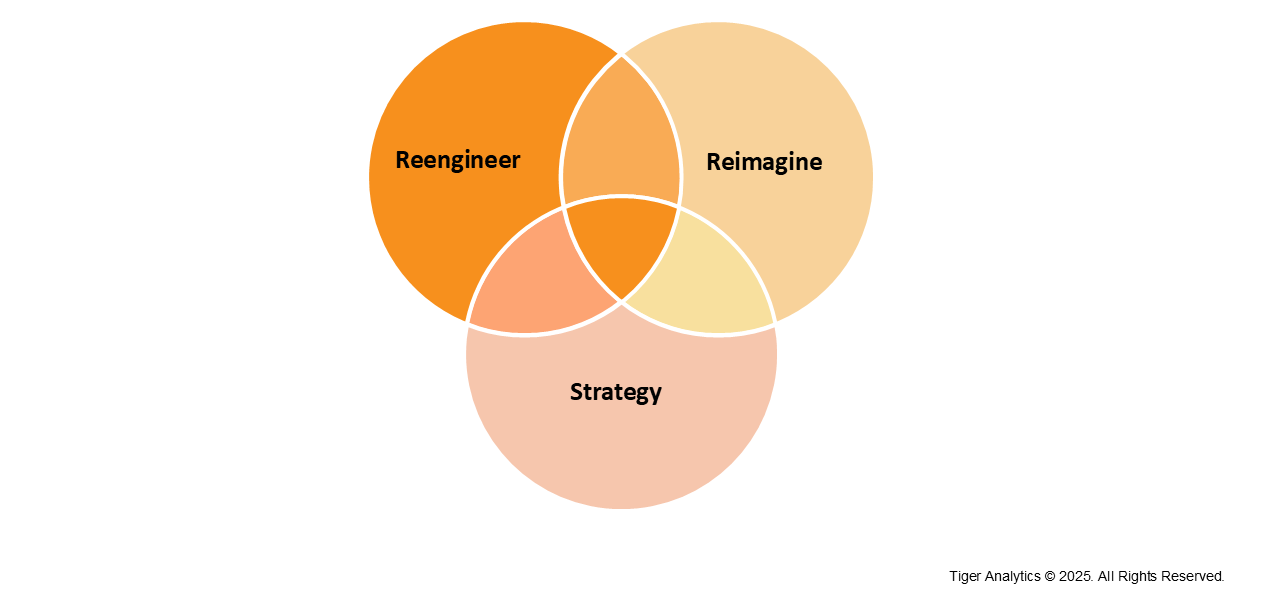
Reengineer:
Know the ‘Agents’ of Change
Imagine a Market Research AI Assistant which could receive natural language inputs from the user (say, Marketing Manager) about the research objectives and output preferences (length, format, tone, etc.), break down the objectives into logical blocks – say primary research surveys, secondary data analysis, synthesis report writing, etc., assign tasks to multiple self-directing AI agents, and when they turn in their assignments, compile those into a comprehensive report (while also receiving occasional feedback from the marketing manager during the process to converge on a satisfactory outcome).
AI Agents are the foundational building blocks of such transformational approaches to the future of work. Agents have a simple but powerful ‘Sense – Think/Reflect – Respond/Act – Remember’ functionality loop, achieved through an assembly of state-of-the-art technology components (reasoning models, language models, connectors/tools etc.)
A group of agents could be combined into a workflow, or to serve as an AI assistant to a business persona, with the ability to handle a wide variety of tasks and workflows. The degree of ‘agency’ can also be calibrated at the individual agent level and at the overall agentic system level, allowing for different levels of human intervention/autonomy as needed. Agents/Agentic systems thus built could be deployed in different areas as you would see in a bit.
Is it that easy? Getting started is, but reliable deployments at scale requires serious engineering effort.
While agents hold significant potential, in the current state of technology, they have a tendency to produce unreliable outputs at times (hallucination being one of the reasons). When a team of agents are strung together, even if individual agents are at 99+% accuracy, the agentic system level reliability could drop far below production quality, coming in the way of deployment.
Structured evaluation frameworks for individual agents and agentic systems, with technology and subject matter (human) experts in the loop is a capability which organizations have to build, to ensure reliable deployments at scale.
Strengthen the Foundation: Enterprise AI Platform
From the previous section, it should be somewhat clear that managing the agent lifecycle – even for a small set of agents – requires a very structured technical approach, from robust development, evaluation, deployment, integration (with other agents or applications), monitoring them for cost, performance, safety, maintaining or retiring. This is achievable through an agentic AI platform.
While an AI platform is not a prerequisite when starting with your first use-case, it helps shape your enterprise AI platform early in your AI journey. This avoids proliferation of agents with limited use and/or unreliable performance characteristics, and ensures that high-quality experiments can scale rapidly and reliably for impact.
If your organization has an existing ML platform, extending that for an agentic world through add-on modules is a possibility. Alternatively, many enterprise systems vendors are already embedding AI into their offerings: Agentforce from Salesforce, Agent Studio from ServiceNow, Agent Bricks from Databricks, etc. Your enterprise AI platform could have one of these as a starting point, with add-ons built and integrated using interoperability frameworks to serve the needs across the enterprise.
Agents are also known to grow in capability over time by leveraging human-user interactions and simple or descriptive feedback for continuous learning.
Given all these possibilities, a well-architected enterprise AI platform could serve as the backdrop for large-scale AI-led business transformation.
Enterprise AI Platforms for Healthcare Insurance – A Use CaseWe are helping a large healthcare insurance provider with an AI platform approach to manage their entire range of model assets, registering, logging, monitoring, and triggering auto/expert fixes for traditional DS/ML models (like classification algorithms), and integrating agentic capabilities (for agent build, registration, logging, and monitoring) and putting it to use on a critical requirement as the initial use-case: intelligent automation of their digital product development. Given the regulatory set-up within which the healthcare industry operates, the degree of transparency provided by the platform and developer productivity unlock are both success metrics based on which the client is expanding the rollout of AI on other use-cases. |
Reimagine:
Cast a wider net: areas to impact through AI Agents
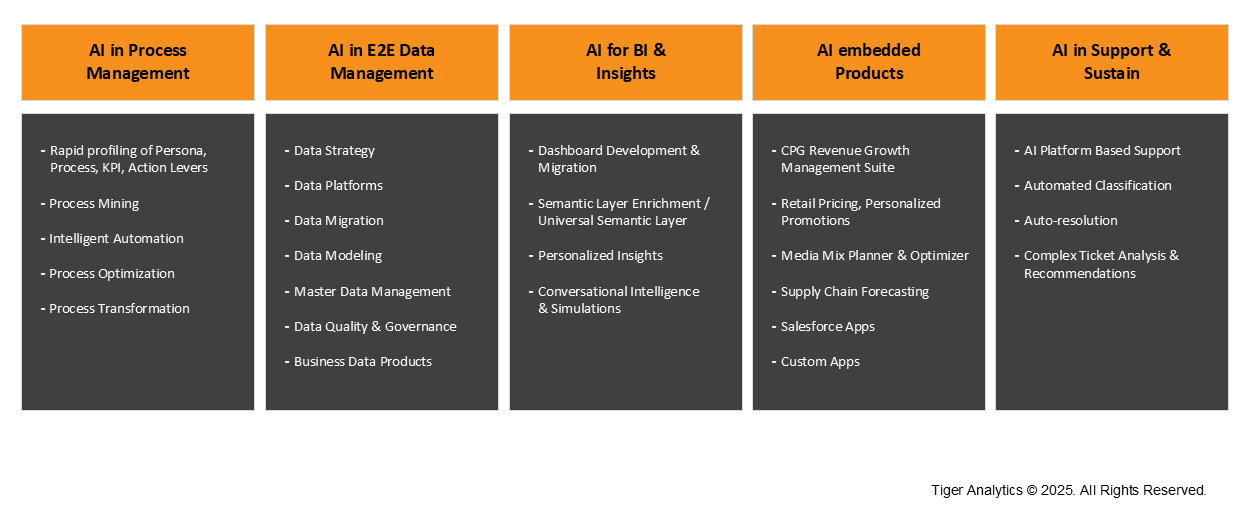
AI in/for Process Management |
| Think of an Order-to-Cash process. Order receipt and confirmation, manufacturing and/or inventory planning, delivery planning, transportation and logistics, delivery confirmation, accounts receivable, and finally, cash (excluding returns, adjustments out) realization.
Any key business process like this, taken end-to-end, has to span multiple systems, data environments, planning software, and involve multiple human users coming together to perform a variety of simple to complex tasks. AI Agents can bring in ‘reasoning-based automation’ by closing one or more gaps in the process chain, unlocking some immediate impact, and keep building on top of that. Another scenario is when custom workflows need to be developed on top of an enterprise software like Salesforce (for e.g. workflow for commercial real estate sales process). There is an opportunity to use a combination of the Salesforce software stack, combined with the power of Agentforce to accelerate the build of such process workflows. |
Example – Digital Marketing & CommerceProduct Information and Content management for digital commerce businesses is a highly dynamic process, and is mired with significant manual effort. We have designed and deployed unique AI-based systems for clients across fashion, art, and home improvement categories. Image-generative AI models generate an array of creative product imagery (in response to human/AI prompts), and text-generative AI models fed with product attributes and human-in-the-loop nudges create accurate product representation, together ensuring content is never stale. Improved process metrics – cycle time for content refresh (product information and imagery), and knock-on effects on business metrics – top-of-funnel traffic, and conversion (up 2%) have been reported within weeks of deploying and integrating these solutions with clients’ digital commerce suites. Combine this with conversational capabilities for consumers to engage with products, and a 2X incremental revenue lift (cost-neutral over a 1-year window) has the promise of significant top and bottom-line impact. |
AI in/for End-to-End Data Management |
| By now, many in the business and technology functions are familiar with the alchemy possible with data: Landing data from a multiple sources into a data lake (often referred to as the source-aligned Bronze layer), cleaning up and curating data around key dimensions and facts (foundational data products in the Silver layer), and creating a range of consumption-ready data products for different business functions in the Gold layer.
AI agents are deployable in every one of these layers: to automate pipelines that hydrate the lake, automated data quality management combining fixed and business reasoning-based logic, interactive data modeling for business analysts and data scientists who could quickly get to purpose-specific, gold-quality data assets that they need for building dashboards, analyses, or predictive models. In addition, there is an interesting opportunity to reimagine how comprehensive data strategy and business context-rich data products could be developed, leveraging AI agents as human companions or idea accelerators. |
Example 1 – Cross-industry deploymentsFor clients across industries, we are actively deploying multiple Generative AI-based accelerators along the data engineering and management lifecycle. Code migration-led data modernization, data pipeline automation, interactive data quality monitoring, data harmonization (for CPG companies, blending multiple retailer + e-tailer data and benchmarking against internal/Nielsen definitions), and interactive data modeling for power users are areas that we have been able to unlock value from, already significantly. |
Example 2 – Financial servicesFor a financial services firm with multiple products in the consumer space, we are developing a comprehensive data strategy. The objective is to build a strong data foundation to support multiple business data products: Customer 360, Product 360, Campaign 360, etc. to drive personalized engagements across the entire customer lifecycle. A unique feature of this engagement is that AI Agents were used as companions to data engineering and banking subject matter experts to accelerate every part of strategy definition: personalized questionnaire generation for discussion with different user personas, summarization of detailed notes from discussions, solution theme identification, prioritization, and roadmap design. What would have taken weeks of commitment from business users came down to hours, bringing significant effectiveness to the data strategy development phase. |
AI in/for Personalized BI and Insights |
| Over the past decade, by enabling business users with a ‘self-service’ experience, BI leaders in many organizations have successfully transformed BI from being an IT deliverable to a shared organizational asset that business and technology collaborate to build, maintain, and enhance. However, going beyond reliable KPI numbers sliced by key dimensions, getting to actionable insights still requires ‘deep drilling’ into dashboards. This can be time-consuming for business users.
Agentic AI holds a promise. Designed to sit atop, or alongside many popular enterprise BI suites (and with access to data in Gold layers, and beyond if needed), AI agents could whip up highly personalized, ready-to-consume, decision moment-specific insights. You get insights curated around the KPIs and action levers you care about the most, drilled to the right level of grain, on your page one! Need to know more? Ask away, and experience highly personalized interactive insights. Not just the user experience, but a lot of enabling activities like efficiently organizing your semantic layer and KPIs (in line with user persona expectations), tracing lineage for faster troubleshooting, monitoring and observability, can also be streamlined through conversational AI. |
Example – Cross-industry deployments“We have too many reports and too many KPIs defined in different BI systems. Is there a way to rationalize” was a problem statement from a global apparel retailer (and an electronics manufacturer, and the VP of HNI Wealth Management of a Financial Services company). Moving away from the traditional approach of taking a report inventory, mapping users to reports, identifying redundant KPIs, and candidate reports to retire/consolidate, which often takes months, we collaborated with the client to ‘reimagine their approach to BI’. A ‘persona-specific insights interface’, which readily recognizes the role of the user and surfaces the most relevant KPIs for the role, along with a tree of potential root causes for KPIs that are off track. Conversational capability for ad-hoc analyses, and a self-serve capability to create a limited set of custom metrics on top of existing data helped balance standardization and flexibility, while cutting down orphan reports/KPIs accrued over time. Improved user experience is an immediate call-out across all clients as an outcome of this ‘Reimagine BI’ approach. From a limited use of looking up KPI numbers from dashboards once or twice a day, users report they are able to leverage dashboards during critical decision moments without having to manually search and apply multiple filters (e.g. guided Q&A during HNI client discussions enabled by chat interface, in addition to smart visual organization multiple KPIs and key action levers connected to those requiring no drill through). |
AI in/for Support – Technology and Beyond |
| On a regular basis, every employee in an organization requires some form of support: infrastructure access-related, business process systems-related, data or insights application-related, and many more. The volume of such support requests is staggering, even for a medium-sized organization. Global organizations spend millions on technology platforms that orchestrate support, backed by shared services organizations that segment and address issues on priority.
Agentic AI offers tremendous promise in streamlining this space, and the biggest value is often relieving stress in support personnel and in the users they support. Creating a unified view of support requests, reasons, ability to detect contagion effect (technology infrastructure disruptions on applications, and business SLA misses), and ability to auto-fix, or summarize poorly articulated complex support requests into manageable chunks for experts to quickly get to solving the issues. |
Example – ManufacturingAn integrated AI-based Tech Support platform is a key component in a global manufacturing client’s bold initiative: to overhaul their technology support process for an enterprise data platform, covering L1, L2 and L3 levels of support. Our platform demonstrated impressive capabilities, including the auto-resolution of low-complexity tickets with a clear line of reasoning and an auditable log, problem summarization, and suggested investigation paths for higher-order issues. Additionally, it provided a control-room view for support managers, and an estimated 20% drop in ticket volumes for support executives due to auto-resolution. Multiple such conversations to implement an AI-driven ITSM process are underway. |
AI Embedded Products and Decision Suites |
| Many critical business decisions are multi-dimensional in nature. Take pricing, for example. From macro-economic variables, to consumer willingness to pay (at micro-segment level), product lifestage, competition dynamics, inventory situation etc.. There is so much to consider. Simulating a wide range of scenarios to get to optimal pricing decisions which balance volume and margins, is a complex exercise.
Industry specific/cross-industry business solutions for pricing, promotions, revenue management, forecasting and inventory/labor planning, media/market mix optimization etc. can now fuse purpose specific data models, razor sharp analytic models (LSTM, computer vision models, for example.), highly intuitive experience layer for different user personas, and AI based conversational capabilities [to enable natural language based interactions with model results for deeper understanding, simulating ‘what-ifs’ one or more dimensions, and create new promotion/campaign configurations]. Such solutions greatly enhance the quality of decisions, assuring value. Identifying areas in your business that are ripe for such solutions, and configuring conversational AI on top of such products/decision suites, is yet another way to unlock value. |
Example – Retail, CPG, Quick Service RestaurantsFor many players in the CPG, retail and quick service restaurants industry spaces, we have delivered multi-geo roll-outs of revenue growth management solutions. As full suites, with their own data model, different analytic model archetypes, and business decision module archetypes for different markets based on data maturity and cost affordability, total promotional spends addressed by these roll-outs are well north of $30 billion, and incremental revenue unlock is to the tune of 1% of the addressed spend (> $3 billion, that is), representing a 10-15% improvement in Return-on-Spend. Conversational and agentic capabilities are getting integrated on top of these solutions with a promise of doubling that impact through increased adoption of analytic tools for RGM decisions. |
Think Human: AI for Personas
Implementing an agentic platform, or applying AI agents in your process, data, BI and support systems could be thought of as coming from ‘Top-Down’. Real impact happens only when the everyday lives of business personas in the organization are made easy. There is an important reason for this.
Any business persona (say, demand planner in manufacturing, insurance underwriter, merchandize planner in retail, fraud investigator in a bank) needs to cut across process, data, BI, and decision suite siloes to deliver on their responsibilities, almost every single day of their work life. [see below, an example of a Revenue growth management analyst in a CPG industry].

So, AI systems that enable them also need to cut across the siloes. We are not talking about just ‘a portal’ that gives a semblance of integration while under the hood data and systems are still siloed.
AI for Personas approach also brings to surface the most important integration challenges: having data that is truly ready for AI (which is addressed by having a robust data strategy and data platform), and integration of AI Agents with execution systems (addressed via platform approach to agentic AI).
Well integrated AI Agents/Assistants unlock the mind space of user personas from repetitive activities which need heavy manual intervention, and reallocate that to think, ideate, innovate, strategize, plan and act.
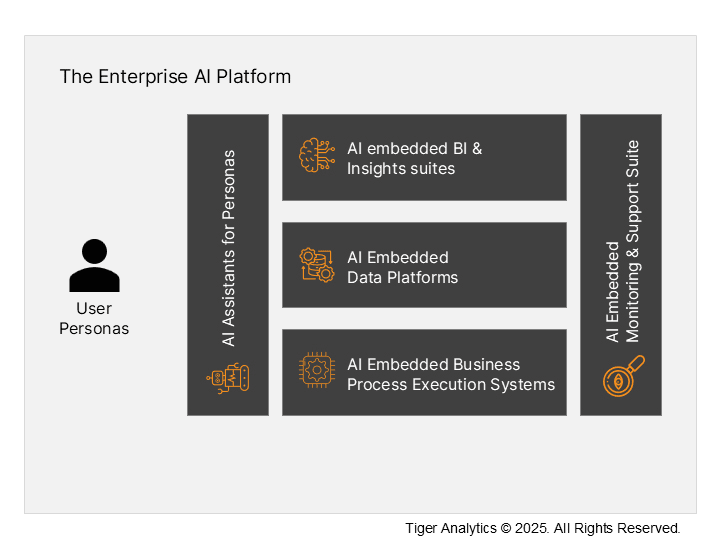
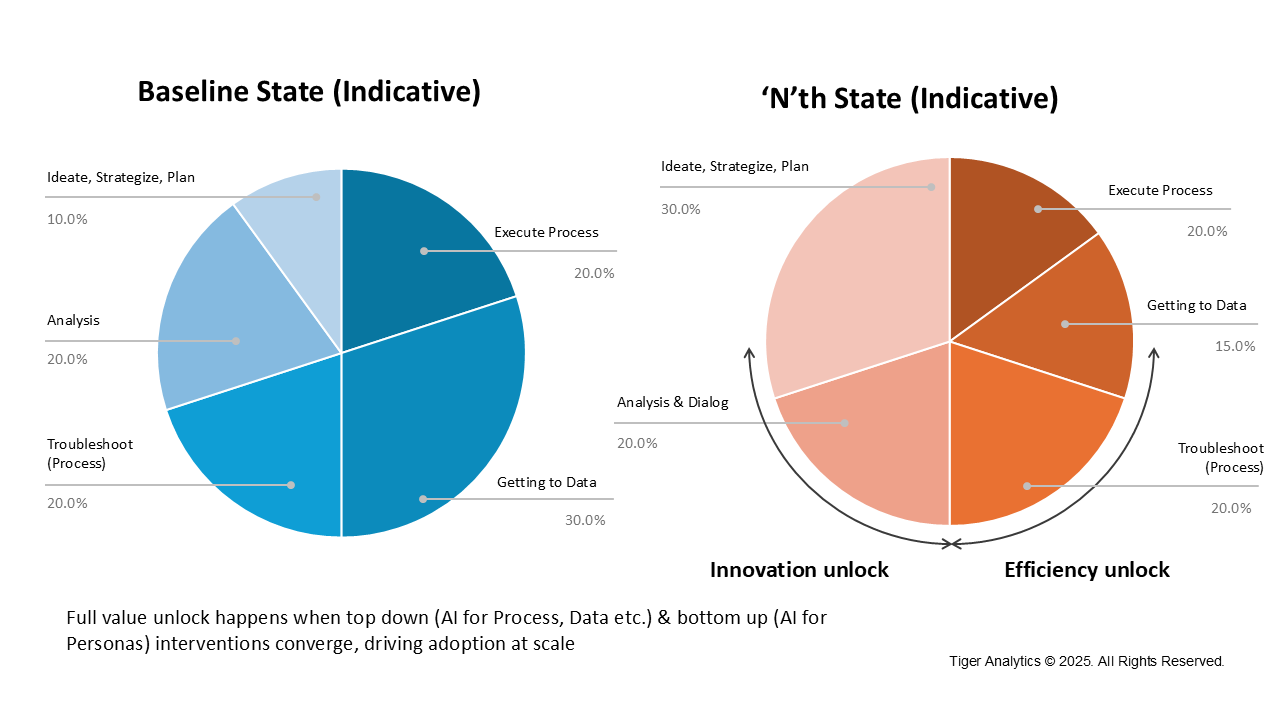
Example – RetailAI for the front-line was a key initiative launched by one of our clients who manufactures equipment for Retail store and Store associate usage. Through Ask<xyz>, a generative AI and Agent based solution, store associates have access to a vast knowledge base – at their fingertips and ready actionable – helping them across a range of actions: from troubleshooting and DIY fixes for in-store label printers, to generating quick and useful product recommendations to help customers in the aisle looking for choices, and much more. This is a classic example of how AI can amplify human potential for the user persona, and improve customer experience for the shopper: a win-win. Early results on both user persona productivity and improved foot-fall to in-store purchase conversions have given confidence to a chain wide roll-out across multiple retail customers. |
[Side bar: Success lies in how you weave AI into your enterprise technology stack to unlock efficiencies, innovation, and revenue opportunities, in YOUR specific organizational context, and how you change the way work environment for business personas in your organization. Seek inspiration from this post from the CTO of Walmart U.S. on how they are unlocking transformation opportunities, in THEIR organizational context and for THEIR business personas.]
The Strategy:
Have a game and team plan to drive transformation
Given the multi-dimensional nature and the magnitude of this transformation opportunity, making real progress without getting lost in complexity and burning time and money, requires a clear strategy, and a significant commitment from the executive suite.
If not already, as an executive, you could initiate an assessment tailored to your organizational context to explore the possibilities with AI – either in a specific area, or an org wide scan. The outcome of this exercise is very useful for building personal conviction and securing alignment among relevant stakeholders within the organization (and the board, where applicable).
The next order of business is to set up an AI strategy & transformation task force (which, after achieving initial momentum could evolve into a formal organization), bringing together: a) technology leaders with exposure to new age AI, and b) business transformation owners, both a) and b) preferably picked from internal leadership pipeline, considering the immense cross functional collaboration required. This ensures there is sufficient focus on contextualizing technology choices with the needs of different business functions and regions of any large global enterprise.
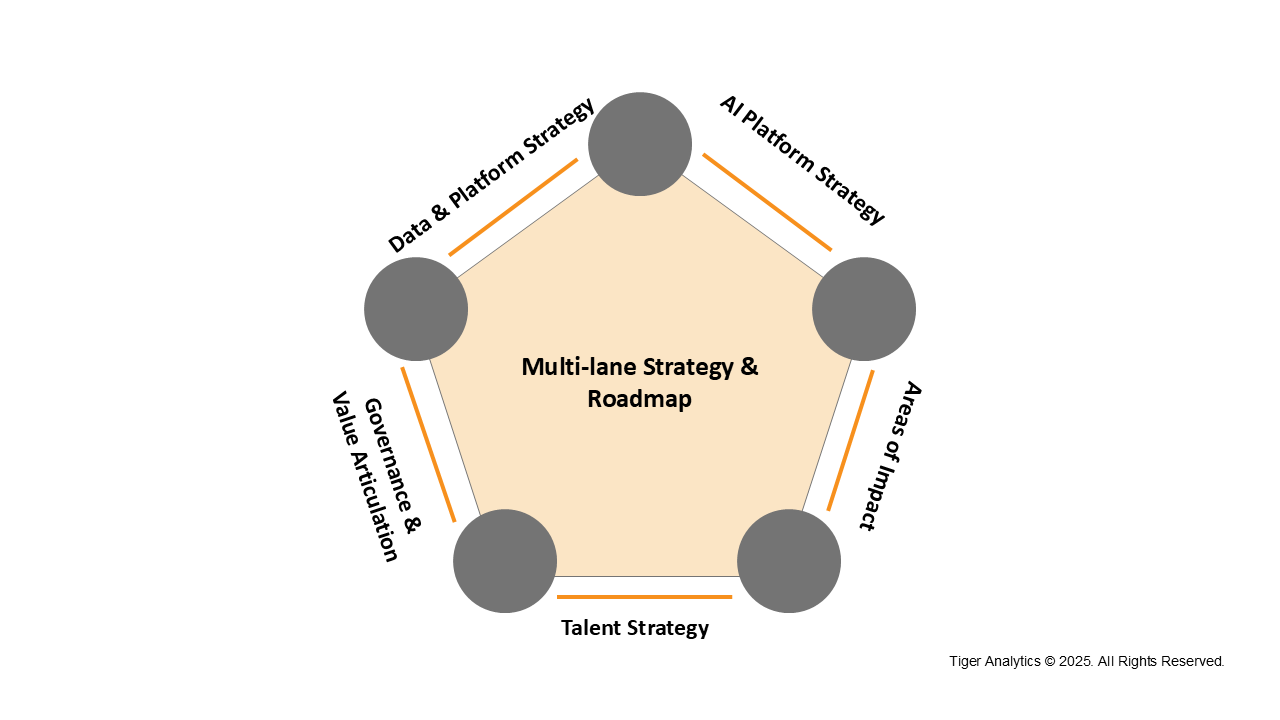
The strategy & transformation team generally has the following items on their charter:
- Craft a very well sequenced, multi-lane roadmap starting from where you are today, opportunities to work on: now, next, and later.
- Size up investments needed in multiple areas (in technology builds and buys), and expected payoffs at different milestones.
- Take stock of talent to execute: in technical, techno-functional product management, and business transformation management areas, from internal and partner channels.A key point to note here is that all talent needed for this transformation need not be centralized. There’s a centralized team – usually deep technical expertise in data management, AI platforms, and a thin layer of techno-functional business product managers to liaison with the business functions, with the rest sourced from within the business function teams: people trained to come up the curve on AI awareness-to-expertise spectrum. The extent of truly AI-ready talent within an organization is one of the key indicators of time-to-value. Being honest about internal talent readiness and augmenting with the right partners can mitigate mid-journey talent stock-out risks.
Talent planning also has another dimension, in terms of imagining and preparing for the target state. When the AI-led transformation kicks in, the future workforce is very likely to have a mix of workflows: some that could be completely autonomous, some that are hybrid, with humans and AI agents working together as a team, and some that could be AI-assisted – AI playing a support role to a human user persona. This will bring training and upskilling needs in some areas, which need to be accounted for in plans, or talent displacement in some areas, which need to be handled with extreme care and empathy for the people involved.
- Set up structures with the right handshakes to enable smooth progress and strong governance to track the pace of transformation. This is done in collaboration with the executive team, as well as with key business leaders in the organization. This builds joint ownership and commitment, without which achieving impact at scale is just not possible.
- Recount stories of early wins and value unlock – internally, and to ‘the streets’ – as and when significant milestones are achieved. Nothing beats stories of team and business wins in driving the adoption of AI across the enterprise.
Closing Note
While specifics of AI-led transformation may vary, like many transformation themes of the past, much of this will be people-led, and for the people. Also, achieving tangible results takes a lot of work, not just from the technology organization, but from everyone in an organization.
Taking advantage of AI at the scale of an entire organization requires a strong network of humans to come together, leverage what AI has to offer to unlock value for customers, for themselves as business personas, and other stakeholders of an enterprise.





